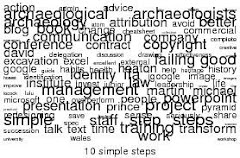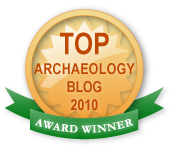In 2007, Randy Pausch, a computer scientist, gave a talk about time management, work, life and everything, conscious that he had an inoperable cancer. The lecture has been turned into a book The Last Lecture
The lecture is also available on Youtube:
Drawing mainly on the work of Stephen Covey and his own experience, he suggests that changing our priorities will make us mnore effective and happier. The whole thing is worth watching; I'd pick out the folliwng five points as the key learning for archaeologists.
1 Mentoring is powerful
We look back fondly on places we did good work. We love places where we learned new things. It's not surprising, therefore, that our emotional connection to our alma mater is so powerful. How can we replicate this level of engagement and loyalty in a company? By repltiucting the core relationship of mentor and mentee, possibly as a formal structure, but at the very least as a key corporate value. An organisation in which people at all levels are clear about their future development paths and can depend on the interest and advice of their superiors is incredibly powerful and resilinet, and doesn't even cost much to implement.
2 Share success with the team
It is inevitable from the shape of archaeological teams that only the senior staff are visible to the wider world of clients, media, and the profession. Some egalitarian managers attempt to overcome this by dragging their staff in to share the limelight, but this is a mistaken approach - what they want is to be respected and valued for the work they HAVE done, not to be given the credit for work they haven't. But make sure that if a project is a success, they know it - share the praise.
3 Don't skimp on tools and equipment
Almsot all the cost of archaeology is the cost of staff time. If someone is idle for an hour because there aren't enough buckets, you've lost the price of a bucket in work. The same goes for computers, screens, everything else: against a year's salary almost all kit costs are trivial. Buy everybody a mobile phone, a GPS, a camera: anything that means they will be able to work smoothly.
4 Delegate
There are enough management tasks that must reside in a single inidividual. Everything esle should be ruthlessly delegated. As with mentoring, this does not just improve effiecioncy, ift changes the atmosphere of the organisation from one that is static with defined roles, into a dynamic place where people can take on new responsibilities in a supportive environment.
5 Life's too short
If an archaeological organisation has reached the point where it is mechanically completing projects to a standardised methodology without generating new ideas and perspectives, it is wasting its time, and that of its staff. We should be bold enough to ask fundamental questions, to explore new topics that are thrown up by our work, to develop new methodlogies and abandon old ones. Life really is too short to spend it doing work that has no value to you or others.
Buy 10 simple steps: the book and the e-book
Transform your business with a 10 simple steps workshop.









